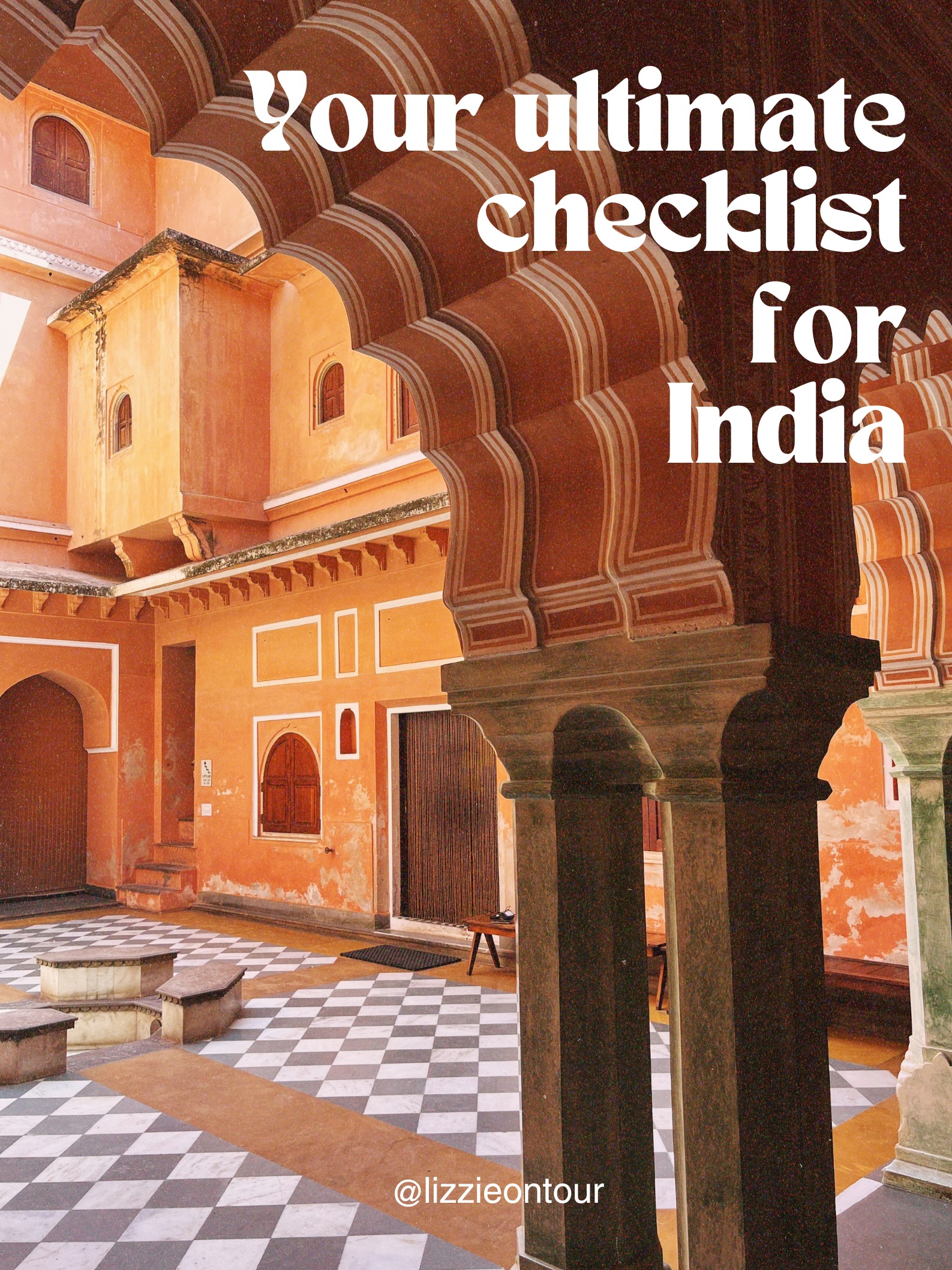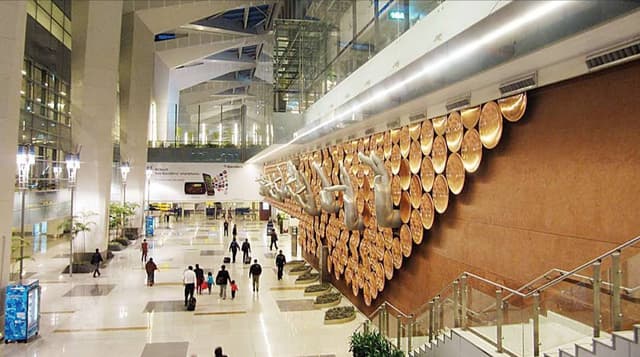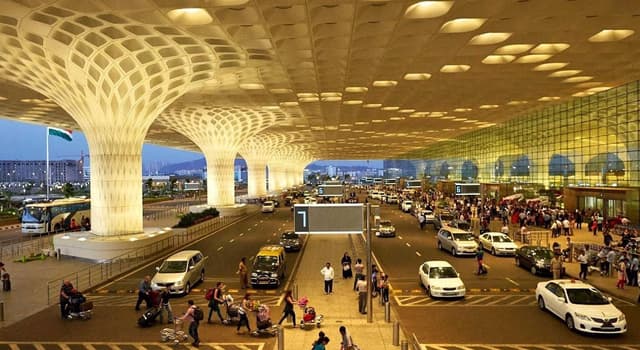The Ultimate Checklist: India

🇮🇳Welcome to India 🇮🇳
India is located in South Asia, bordered by Pakistan to the northwest, China and Nepal to the north, Bhutan to the northeast, and Bangladesh and Myanmar to the east. To the south, it is surrounded by the Indian Ocean, with the Arabian Sea on the west and the Bay of Bengal on the east.
The Essentials
☀️ Weather
India's weather is as diverse as it's culture; with hot summers (March to June), a monsoon season with heavy rains (June to September), a pleasant post-monsoon period (October to November), and cool winters (December to February).
Northern regions such as Delhi and Rajasthan can experience extreme temperatures with highs of 50C in the Summer, and lows of up to -5C in the Winter. While Southern regions and coastal areas such as Mumbai, Goa and Kerala, the weather is more consistent with temperatures between 26-30C year around. However South India does tend to be more humid, with Monsoon season lasting a little longer than North India.
The best time to visit India really depends on which region you are going to, however as a rule of thumb for first time visitors - the best to visit is while the weather is cooler and there is no monsoon - October to March would be the ideal time to explore. But of course check before planning a trip to make sure the climate is suitable for your adventures!
🧧 Money Matters
Currency: Indian Rupee
In most cities/urban areas, credit and debit cards are widely accepted in restaurants, shops and hotels. However make sure to have a little bit of cash on you just in case - for local markets and street vendors cash is a must!!
ATMs are widely available in most cities, however if you are going off the beaten path we'd recommend getting enough cash to cover your trip in advance.
Tipping is common in restaurants (around 10-15%), as well as for drivers and tour guides.
💬 Language
Official Languages: Hindi and English
Although Hindi is the official Language of India, there are regional languages that differ region to region, with the biggest 3 being Bengali, Marathi and Telugu.
🛜 Connectivity and Wifi
Wifi is widely available in all hotels and the majority of cafes, restaurants and malls.
Purchasing SIM cards in India can be a bit tricky and require some paperwork/documentation (Including but not limited to: local address, passport, visa). These can be purchased at some of the international airports - including Delhi and Mumbai airport.
An alternative to SIM cards are eSIMs, an eSIM is a digital SIM card that you can download on your phone and use for the duration of your trip (link below)
🔌 Plug and Sockets
India uses plug type is D, which is the plug that has three round pins in a triangular pattern. Additionally, Type C plugs (two round pins) are also commonly used and fit into Type D outlets. India operates on a 230V supply voltage and 50Hz.
🆘 Safety and Emergency Numbers
Police: 111
Ambulance: 102
Fire: 101
Tourist Helpline: 1363 (available in multiple languages)
Travel and Transport
🛫 Air
India has a total of 127 airports with 32 international airports, which means that air travel is convenient across India and allows you to explore to your hearts content.
I've listed out the 3 biggest airports across the region before for your reference.



🚝 Public Transport
Public transport in India is well-developed, especially in urban areas and major cities such as Mumbai.
Although the public transport network is well developed in India, there are a few things to note. Public transport is affordable and extensive, however can get extremely crowded during peak hours, additionally there are varying levels of cleanliness.
We would recommend sticking to the Metro system which is clean and effective in larger cities such as Mumbai, Delhi and Bangalore. As well as the national wide train service which is effective for traveling from city to city. There are different class groups on the trains, we would recommend AC First Class or AC Tier 2 for tourists visiting.
🚙 Road
Car rentals are available at the majority of large international airports as well as in most larger cities. Make sure to check online with your provider before booking!
However roads in India can be chaotic and vary in conditions. We'd recommend hiring a car and driver, that way you get the benefit of a driver who is experienced with the roads and conditions, as well as the traffic norms!
For quick trips within a city you can use a taxi app, our personal favourite after 4 years in India is BluSmart, the car tends newer than that of other taxis and a little cleaner. However the only downside is that they have to be prebooked on the app. For immediate cars, try Uber and Ola.
🍲 Food and Culture
India's food and culture are deeply intertwined, with each region of India having it's own food, customs and cultural practises. India is home to a variety of ethnicities, languages, and religions. Some of the widely practised regions include: Hinduism, Islam, Christianity, Sikhism, Buddhism, and Jainism.
The food in India is so diverse and differs region to region, and have an amazing variety of vegetarian options. Here are a few must tries, for more recommendations head to my blog (linked below).
Top tip - Drink only bottled or filtered water, and avoid street food if you have a sensitive stomach.
🧳 Packing List
You're almost set to go! I've complied a list of a few must haves on your trip to India to make you are able to make the most of your trip!
🧴 Sunscreen and insect repellent - because no one wants sunburn and mossys ruining their trip
🧣 A Sarong or Scarf - useful for covering up when visiting religious sites or if it gets chilly in air-conditioned spots.
☂️ Rain Jacket or Umbrella - for sudden rain showers, particularly during the monsoon season
📱Useful Apps
Thank you for reading and make sure to save for your future reference!
For bonus tips and tricks head to my blog
The home for unique & authentic travel
